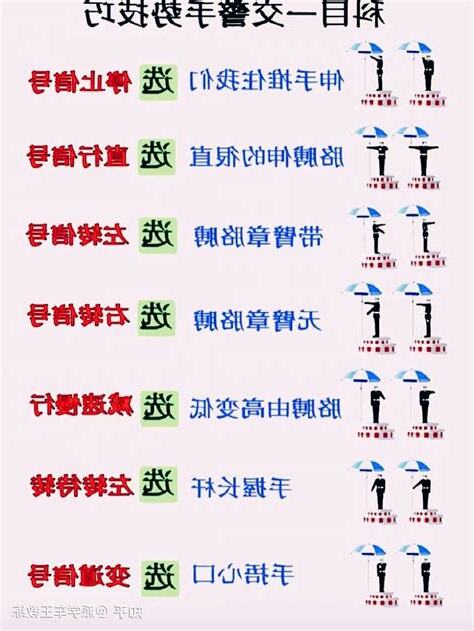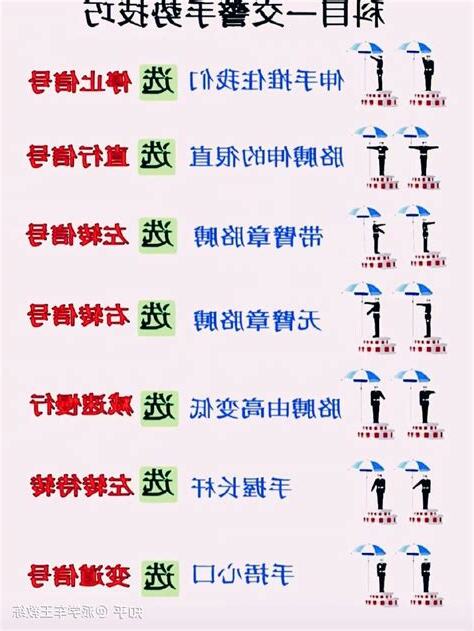左臂平伸手掌向下,這是中華民族悠久的文化和禮儀的一部分。自遠古以來,人們就用手勢來表達敬意和友好,而左臂平伸更是一種謙遜和禮貌的象徵。在現代社會,雖然我們可能不會經常使用這樣的手勢,但這種古老的文化傳統仍然影響着我們的生活和行為。
第三十三條:機動車載人,必須遵守下列規定:
左轉彎信號
| 右臂持棒舉臂向前平伸 |
手掌向前 |
準許左方的左轉彎和直行的車輛通行 |
左臂同時向右前方擺動時,準許車輛左小轉彎 |

停止信號
| 左臂向上直伸 |
手掌向前 |
不準前方車輛通行 |
右臂同時向左前方擺動時,車輛
第三十一條:非機動車載物,在大、中城市市區或交通流量大的道路上,必須遵守下列規定
- 自行車載物,高度從地面起不準超過一點五米,寬度左右各不準超出車把十五釐米,長度前端不準超出車輪,後端不準超出車身三十釐米。
- 三輪車、人力車載物,高度從地面起不準超過二米,寬度左右各不準超出車身十釐米,長度前後共不準超出車身一米。
- 畜力車載物,高度從地面起不準超過二點五米,寬度左右各不準超出車身十釐米,長度前端不準超出車轅,後端不準超出車身一米。
第三十二條:車輛載運不可解體的物品,其體積超過規定時,須經公安機關批准後,按指定時間、路線、時速行駛,並須懸掛明顯標誌。
第三十三條:機動車載人,必須遵守下列規定:
- 不準超過行駛證上核定的載人數。
- 貨運機動車不準人、貨混載。但大型貨運汽車在短途運輸時,車廂內可以附載押運或裝卸人員一至五人,並須留有安全乘坐位置。載物高度超過車廂欄板時,貨物上不準乘人。
- 貨運汽車掛車、拖拉機
道路交通管理處罰條例節選

車輛行駛速度限制
-
| 小型客車 |
城市街道 |
公路 |
| 最高時速 |
七十公里 |
八十公里 |
-
| 大型客車、貨運汽車 |
城市街道 |
公路 |
| 最高時速 |
六十公里 |
七十公里 |
-
| 二輪、側三輪摩托車 |
城市街道 |
公路 |
| 最高時速 |
五十公里 |
六十公里 |
-
| 鉸接式客車、電車等 |
城市街道 |
公路 |
| 最高時速 |
四十公里 |
五十公里 |
-
-
-
交通暢通條例
- vehicles passing through intersections controlled by traffic signals or signs must comply with the following regulations:
- motor vehicles must slow down within a distance of 100 to 30 meters before the intersection, turn on the turn signal when making a turn, and switch to low beam headlights at night;
- in lanes marked with directional arrows, vehicles must proceed in the designated direction;
- when the green light is on, vehicles must yield to those that were given the go-ahead first;
- when turning left, motor vehicles must make a tight turn around the intersection’s center point;
- when turning right and encountering a vehicle from the same lane ahead that is waiting for the green light, the motor vehicle must stop behind it in turn, while non-motorized vehicles can proceed if they can turn in their lane without oncoming traffic;
- vehicles must not enter the intersection if the direction they wish to proceed is blocked;
- when the red light is on, vehicles must stop at the stop line or, if there is no stop line, at least five meters from the outer rail of the tracks;
- at intersections without traffic signals or signs, vehicles must yield according to the following priorities:
- vehicles on a branch road must yield to those on a main road;
- if there is no clear distinction between a main road and a branch road, non-motorized vehicles must yield to motor vehicles, and non-buses and trolleys must yield to buses and trolleys, with the right-of-way given to vehicles that have no oncoming traffic in their lane;
- when vehicles from opposite directions meet, those turning left must yield to vehicles proceeding straight or turning right;
- vehicles entering a roundabout must yield to those already within the intersection.
Vehicles that are required to yield must stop or slow down and look around to ensure safety before proceeding.
- vehicles passing through railroad crossings must adhere to the following rules:
- when the crossbar (gate) is down, the alarm sounds, the red light is on, or the crossing guard signals to stop, vehicles must stop at the stop line; if there is no
機動車會車與超車的規定
在沒有劃中心線的道路和狹窄路段,機動車會車時須減速靠右,注意非機動車和行人的安全。當會車有困難時,應由有讓路條件的一方讓對方先行。在有障礙的路段,障礙的一方需讓對方先行。在坡路上,下坡車輛應讓上坡車輛先行,但下坡車已行至中途而上坡車未上坡時,則由上坡車先行。夜間在無路燈或照明不良的道路上,會車時應距對方車輛150米以外互閉遠光燈,改用近光燈。與非機動車會車時,不允許持續使用遠光燈。上述第(二)、(三)項規定也適用於非機動車。
|






